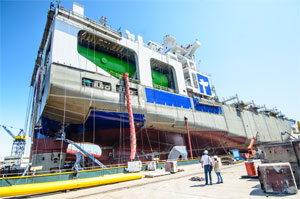Five years ago, shipowners questioning whether liquefied natural gas was the fuel of the future could cite two simple reasons for not making the move: There wasn’t enough supply infrastructure in place to create demand for LNG-powered ships, and there wasn’t enough demand for LNG ships to stimulate investment in infrastructure.
Last year, the crash in the global oil market gave more weight to skeptics’ arguments. As prices plummeted, any cost advantage that LNG might have gained due to increased U.S. production quickly evaporated. Going “dual fuel” had obvious emissions-related benefits, but why invest in an LNG conversion or newbuild if there were other ways to achieve compliance amid the flow of cheap oil?
For TOTE Maritime, the answer had nothing to do with the price of fuel and everything to do with the environment.
In 2010, the company began exploring the possibility of converting its two Orca-class containerships, Midnight Sun and North Star, to LNG propulsion. Two years later, it made the decision to go forward, raising the ante in the process by committing to a pair of dual-fuel newbuilds.
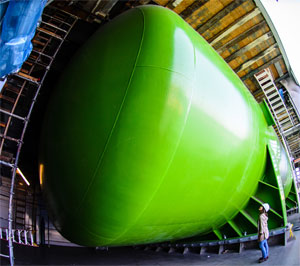 |
|
The two deck-mounted LNG tanks are 84 feet long and can hold a combined 475,000 gallons of fuel. Bunkering initially will be done by truck. |
|
Brian Gauvin |
The first of those Marlin-class vessels, Isla Bella, is the first LNG-powered containership in the world. Designed by the Daewoo Ship Engineering Co. (DSEC) of South Korea and built by General Dynamics NASSCO in San Diego, it was scheduled for delivery in late 2015 for the Florida-Puerto Rico trade.
Anthony Chiarello, president and chief executive officer of TOTE Maritime, said the company never hesitated after the decision was made to commit to LNG.
“We knew it was the right thing to do,” Chiarello told American Ship Review. “There were many, many benefits to going with LNG from an environmental perspective, benefits that we felt were going to last for years and years to come.”
While the cost of fuel is a constant concern for shipowners, Chiarello said the variables in the LNG market didn’t factor in to TOTE’s shift in direction.
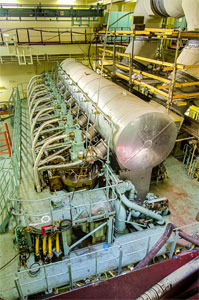 |
|
Isla Bella’s dual-fuel, slow-speed MAN main engine, above, can deliver 25,191 kW at 104 rpm. Service speed is 22 knots. |
|
Brian Gauvin |
“When we made the decision, we had no idea what the cost of LNG was going to be,” he said. “It was based solely upon the positive environmental impact and the fact that ECA (Emission Control Area) laws were going to be such that we didn’t think there was a viable solution other than going to an alternative fuel, because the other solutions, such as scrubbers, all they did was treat the problem. We are still not sold that scrubbers are a viable option yet.”
Emissions from the 764-foot, 3,100-TEU Isla Bella will be a fraction of what is produced by a comparable ship burning heavy fuel oil. TOTE estimates that the Marlin class will achieve a 98 percent reduction in nitrogen oxide, a 97 percent reduction in sulfur oxide, a 72 percent reduction in carbon dioxide and a 60 percent reduction in particulate matter.
To achieve those reductions, TOTE needed supply infrastructure that did not exist when the company made its decision to go with LNG. Chiarello said officials debated long and hard about whether that component would fall into place, but since the decision was being driven by environmental considerations, “we just said we’ll figure it out.”
“We did enough preplanning with vendors that we felt comfortable enough that we could get supply in the two locations where we were going to need it at the time that we needed it,” he said, referring to Jacksonville, Fla., for the Marlin class and Tacoma, Wash., for the Orca class. “But there were a lot of moving parts. When you’re coming to the table with only a percentage of the off-take of a liquefaction facility, it makes it more challenging for the providers to kind of roll the dice about whether they’re going to have other players come to the table on the demand side.”
Chiarello said Isla Bella will burn “100 percent LNG” inside and outside of Emission Control Areas. Dual-fuel capability was included in part to make sure the vessel is available to the U.S. military in the event of war.
“We had that happen to one of our Ponce-class ships back in (Operation) Desert Storm,” he said. “If we were just solely LNG, with the availability of the fuel questionable globally for the foreseeable future, who knows where those ships might end up. So we have normal tankage for distillate as well that is available on the ship if and when necessary.”
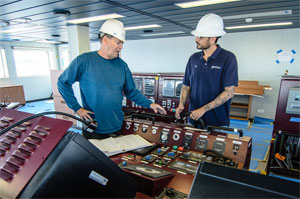 |
|
Dave Smith of CS Marine and Ian Cain of CS Controls confer on the bridge about the ship’s steering and control systems. |
|
Brian Gauvin |
Isla Bella’s propulsion is provided by a dual-fuel MAN 8L70ME-C8.2GI main engine, built by Doosan in South Korea under license from MAN Diesel & Turbo. A patented supply system from Daewoo Shipbuilding & Marine Engineering (DSME), the parent company of ship designer DSEC, converts the LNG to natural gas and delivers it to the slow-speed, two-stroke power plant.
The highly visible focal points of the new ship are its two 84-foot-long LNG tanks. Manufactured by Cryos and painted a vibrant green, the massive steel containers weigh 380 tons each and can hold a combined 475,000 gallons of LNG. They are mounted above the main deck aft of the accommodation space, adjacent to the LNG bunkering stations and directly above the engine.
Although the tanks take up the equivalent of 50 to 55 cargo slots, “it’s not a major number” considering the total capacity of the 3,100-TEU ship and the length of its voyages, Chiarello said.
“Now for an international carrier who’s trying to go 8,000 or 9,000 nautical miles, the tankage is going to be much larger, it’s going to be a larger component of it,” he said. “But for us, being on a short run of 1,100 or 1,200 nautical miles, the tankage that we need is significantly less and the impact on cargo-carrying capacity is significantly less. A Jones Act carrier was probably best positioned to be the first going into LNG containerships because they’re short runs.”
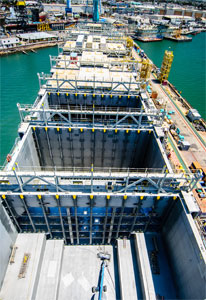 |
|
Isla Bella and Marlin-class sister Perla del Caribe each will be able to carry 3,100 TEU in their holds, above, and on deck. |
|
Brian Gauvin |
Making sure that every piece of the LNG puzzle could stand up to regulatory scrutiny added to the design and build challenge. The installation is larger than other marine applications of LNG as a fuel but much smaller than systems for LNG carriers. Isla Bella is also only the second LNG-powered ship in the United States, meaning it is relatively new technology for the American Bureau of Shipping and the U.S. Coast Guard to assess. (The nation’s first LNG-powered vessel, Harvey Energy, was American Ship Review’s Ship of the Year for 2015.)
The result is a long list of safety systems aboard Isla Bella, including water spray, water mist, double-walled piping in sensitive areas, gas detection, an emergency shutdown device and the ability to seamlessly switch from LNG to diesel if necessary. The inner wall of each double-walled tank is stainless steel, with the space between filled with evacuated perlite to reduce LNG boil-off rates.
Parker Larson, director of commercial programs for General Dynamics NASSCO, said the shipyard spent extensive time with the Coast Guard and ABS during the design phase to make sure their concerns were addressed. NASSCO’s experience with DSEC also helped the yard get ahead of possible regulatory issues.
“We have a nine-year relationship with DSEC as a design and procurement agent, so we know their capability,” Larson said. “There are integrated standards and processes for handing off the design to NASSCO so we can plan and build the ship, and there are a lot of feedback mechanisms. They stay with us really until the end of construction to help knock down challenges or problems.”
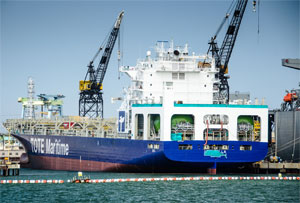 |
|
The view of the stern of Isla Bella is dominated by its twin green Cryos LNG tanks. |
|
Brian Gauvin |
NASSCO learned a few lessons while building its first LNG vessel — knowledge that has proven helpful in the production of its second, Perla del Caribe, Isla Bella’s sister, which was launched in late August at the shipyard.
“One of the biggest lessons we learned was how we manage the stainless-steel double-wall piping joints,” Larson said. “We determined what piping could be done offsite, supplied to us by Cryos. They give us this entire assembly and we only have to do these connection points. So we maximized that as much as possible, but it was still something that we realized we had to tightly manage. I think in the big picture we had a lot of success because our first-time pass rate (X-ray quality testing) was in the mid-90s, which is very good.”
LNG bunkering for Isla Bella’s system tests and sea trials was done by truck at NASSCO. When the ship is delivered and operational it will refuel initially by truck, then at a LNG liquefaction facility being constructed in Jacksonville by Pivotal LNG and WesPac Midstream LLC.
Louisiana-based Conrad Shipyard has contracted to build a dedicated LNG bunker barge — the first in North America — that will supply TOTE’s Orca-class ships in Tacoma when their conversions are complete in early 2016 and early 2017. Puget Sound Energy is planning an LNG terminal at the Port of Tacoma that eventually will fuel the Orcas, with the Conrad-built barge being moved to Jacksonville to serve the marine LNG market there.

